Your donations help T1Determined #keepgoing.
20-Year Update: My Evolving Perspective on Running Gear
When I first started running back in 2004, I really didn’t know what to wear or why.
In fact, I remember going to Dick’s Sporting Goods, finding on-sale shorts and technical shirts in my size, and getting them all. I was sold on the IDEA of running, but I had no idea how to do it.
It turns out that the REASON those shorts and shirts hadn’t sold had a lot to do with the weight of the fabric. It was dense, hot, and swaddling, and what makes it worse is that the fabric Just Didn’t Break Down. Twenty years later, I still have them, and I use them when I need to take a gardening day.
Since then, I’ve gotten into longer and longer runs with challenging considerations, but the basic question of “what to wear” remains.
Shorts
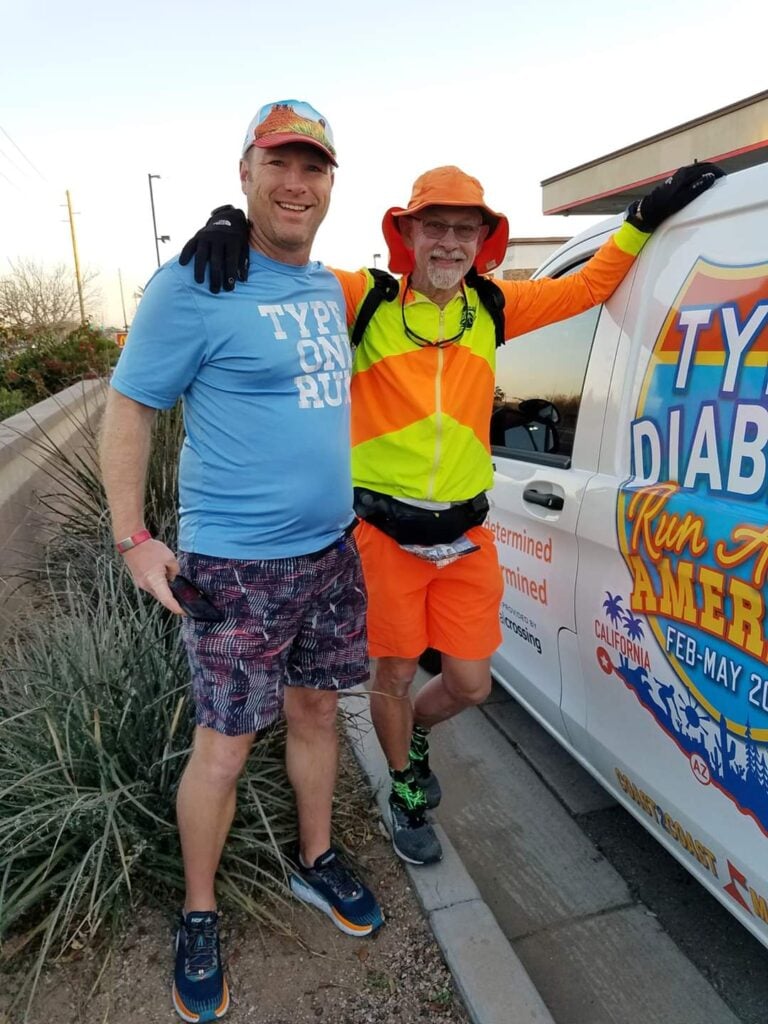
One of the things I learned quickly as I started running longer distances is that you “bleed” a lot of heat from your lower torso, and sometimes you WANT to bleed that heat. Having a part of your body under-covered helps keeps your torso from overheating. NOT doing that means sweating inside your warm clothes, which ironically feel freezing cold when you finally take off that outer layer to cool down.
When I started my run across the U.S. in February 2020 just after monsoon season and early enough to get to the East Coast before it got hot, the average daytime temperatures were just above freezing. I wore several warm layers on top, as well as gloves. But I wore shorts on the bottom nearly the whole time, until I hit torrential rain just outside El Paso.
Those shorts had to be thin to keep my legs cool, bright to be visible, and have pockets that were big enough to hold an extra bottle of water or snacks but secure enough to not jostle around while running.
I ended up settling on Under Armour for most of the U.S. run, and while my needs have evolved a little since then, they’re still good shorts. I just wish they still made them in fluorescent colors.
Shirts
Cold Weather
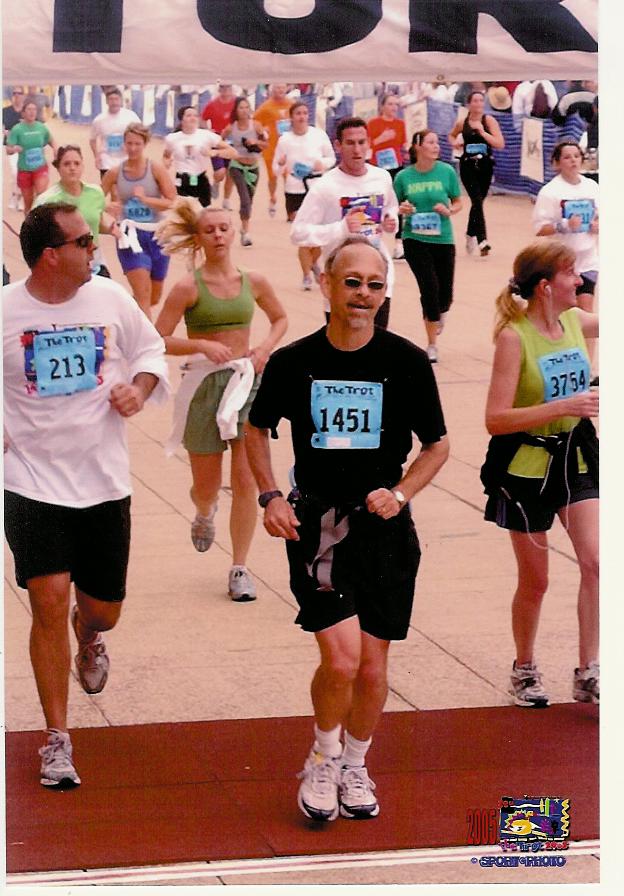
When I did my first actual 5K run at the 2004 Dallas YMCA Turkey trot, I wore one of the shirts and a pair of shorts I got at Dick’s Sporting Goods. Solid black certainly wasn’t very visible, but then again I was in a big crowd of people. Despite the fact that black retains heat, it didn’t help much on that November day, when temps were in the lower 40s (F). Most runners wore black garbage bags while milling around at the start just to keep from freezing. And I didn’t wear a hat, either.
Like I said, I didn’t know what I was doing. But I got by.
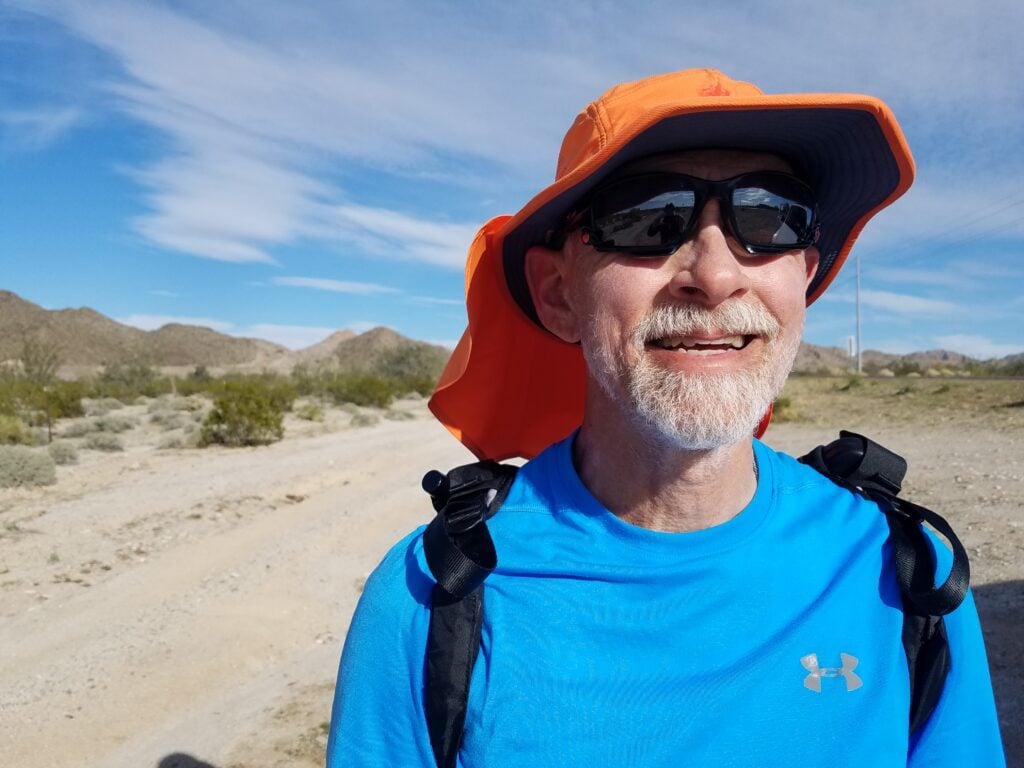
Sixteen years later, I was a lot smarter. I had gotten wrap-around sports glasses that would take a rock at 60 miles per hour, a sun hat designed for desert running, a hydration quiver that balanced on my back, and I’d figured out shirt layering.
I also learned about the benefit of long-sleeved shirts; specifically, that they protect you from the sun even when you think they will make you feel hotter. I usually wore the “normal” short sleeve shirt on the outside on colder days to keep my torso warm, but seldom wore anything other than a long-sleeved shirt, or at best, sun sleeves, underneath.
And as I got more and more involved in running in the Texas and California desert heat, I would learn just how important long sleeves were in keeping wind and blowing sand from chafing my skin raw.
Hot Weather
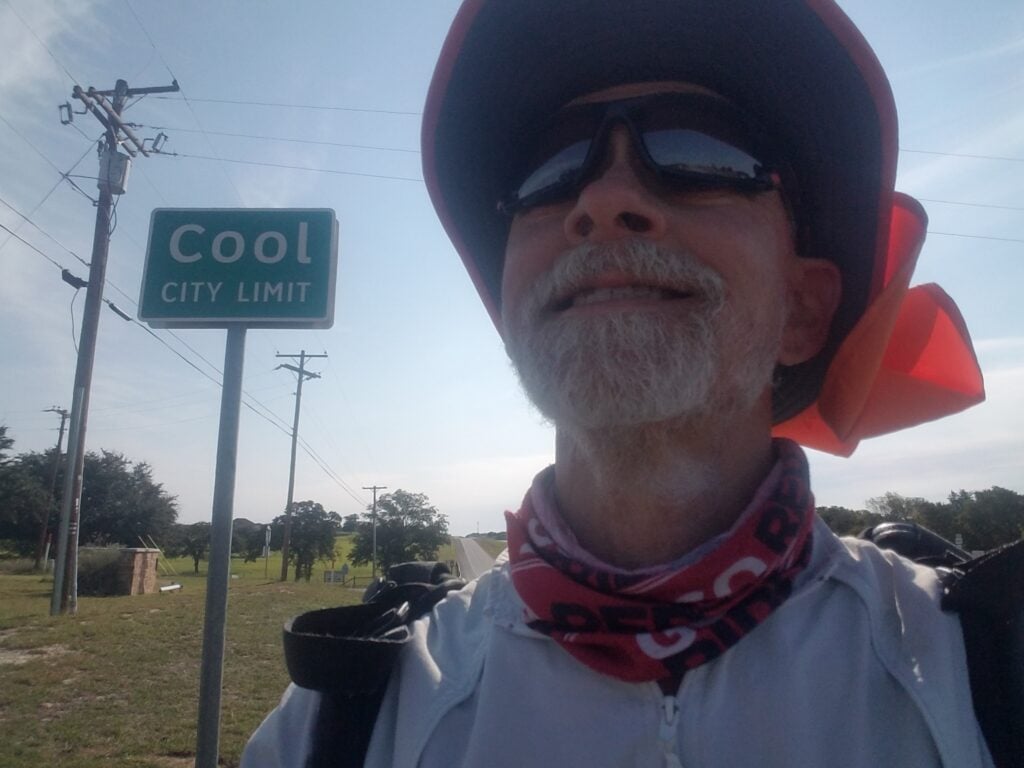
March 2020 threw a giant wrench into the works for my planned 88 day run across the U.S. The outbreak of Covid slipped my arrive-by-May plans by 6 months due to the fact that at the time, there were no vaccines, hotels were closed or didn’t have reliable air circulation, and–most of all–people had been making “prepper-like” runs on grocery stores, which meant we couldn’t resupply the van, at least not in quantities we were used to. Things like toilet paper were limited to one package a person and most of the shelves were empty of all but the most wretched flavors of everything. If I wanted habanero chili-limon flavored certified vegan chickpea snacks, I was in luck. Otherwise, no dice.
As a result, we didn’t resume my running schedule until September 2020, by which time summer was in full force, punctuated only occasionally by brief breezes just below body temperature.
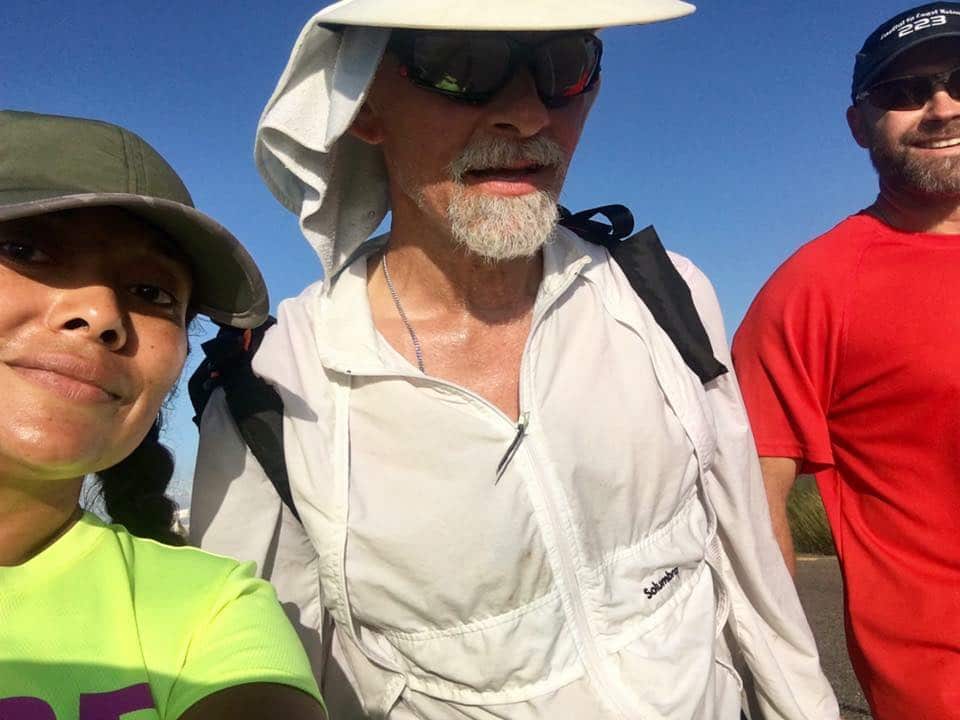
I began to rely more and more on my one-and-only Solumbra Ultra Athlete desert running shirt, a garment used by Badwater 135 and Marathon des Sables athletes, that took design cues from Bedouin robes worn in the Sahara. It consisted of dual layers of extremely thin white nylon that served multiple purposes: breathe what air it could, reflect as much sunlight as possible, and when temps were above body temp, capture the little heat that made it past the FIRST layer of nylon OUTSIDE the second layer, “chimneying” it toward the neck opening. It works on the same principle as passive ventilation in trail toilets in national parks. The idea is that if it’s hotter at the top and open to airflow, the hot air moves out of the enclosure as the laws of thermodynamics force it to rise and expand.
When temps were BELOW body temp, I wore DeSoto skin cooler sleeves and poured water on them to enhance evaporation.
Hats
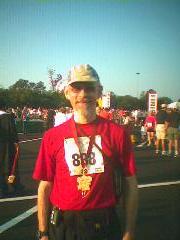
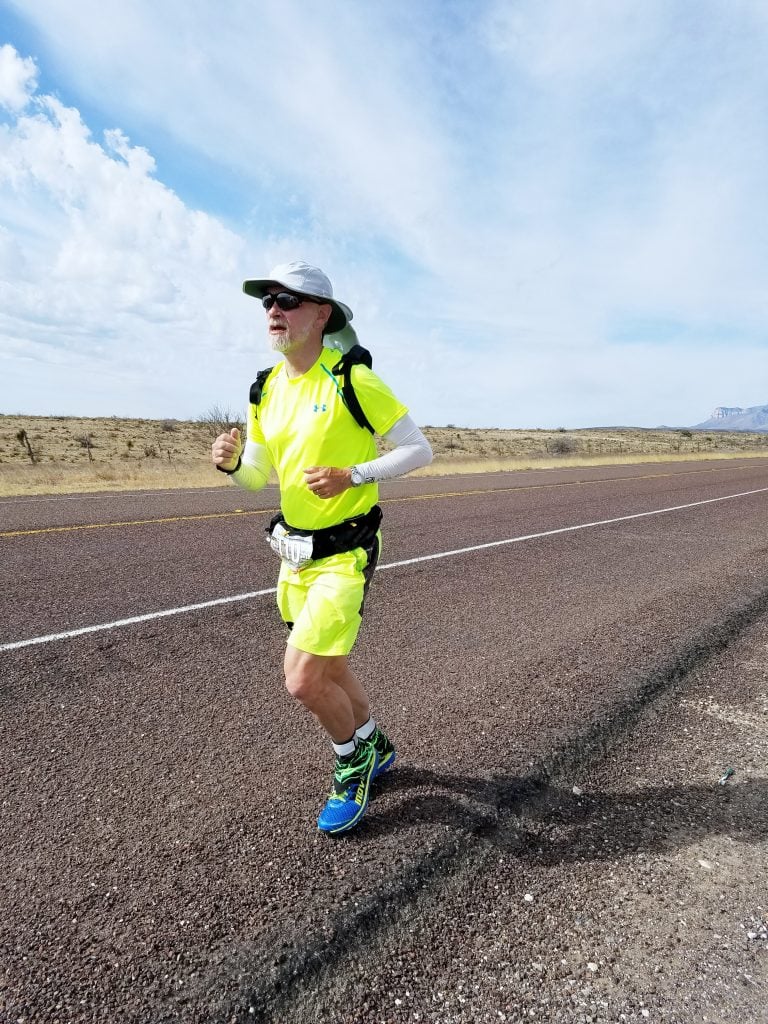
When I first started running, I wore typical running caps I found at stores. They were, for the most part, breathable and did a good job of wicking away sweat…especially the souvenir caps made by BOCO.
However, they didn’t do a very good job of keeping the sun out of my eyes.
I experimented with the Solumbra Ultra Athlete running cap. You can see me wearing it in some of the pictures above. It has a VERY broad white brim and did a fantastic job of keeping the sun of of my face. But the Solumbra hat was hot. The double-layered nylon that had done such a good job cooling my torso was cooking my head, and it was not as well ventilated as even a cheap running cap.
Which left me with a problem: where to find a GOOD desert running hat that not only fought off the sun but let my head cool off.
During the U.S. run I almost exclusively wore a Shelta Hats Raptor 2 desert running hat with Kalahari neck flap. This is a stiff-brim lightweight running hat that looks like the love child of hats worn by Crocodile Dundee and the French Foreign Legion. It has an adjustable neck strap that can be threaded through a hole in the back of the hat when it’s not windy. It has a “secret pocket” in the front that can hold a gel, car keys, or similar. And it has a huge removable flap in the rear to keep the sun off your neck. The flap actually attaches in a fashion similar to the neck strap — namely by threading fastening points through grommets — so that you can take the flap off OR adjust it to be a bandana when there’s dust in your face. It’s incredibly breathable as well, which makes running in the heat pretty forgiving.
The one exception I might make to using a Raptor 2 would be if I were going long periods with the sun at the SIDE of my face. Now, this would be a limited set of circumstances–a time of year when days were longer and hotter but the sun wasn’t really right above your head as much as lingering on the horizon. Or perhaps when you’re in an environment where there’s a lot of windblown sand, as there is at the Marathon des Sables in Morocco. In such cases, I might use an Outdoor Research Sun Runner hat, but I never faced those situations. While the visor is pitifully unusable, the white color and the side flaps do a good job of protecting the face, and it’s probably why a lot of Badwater athletes use it.
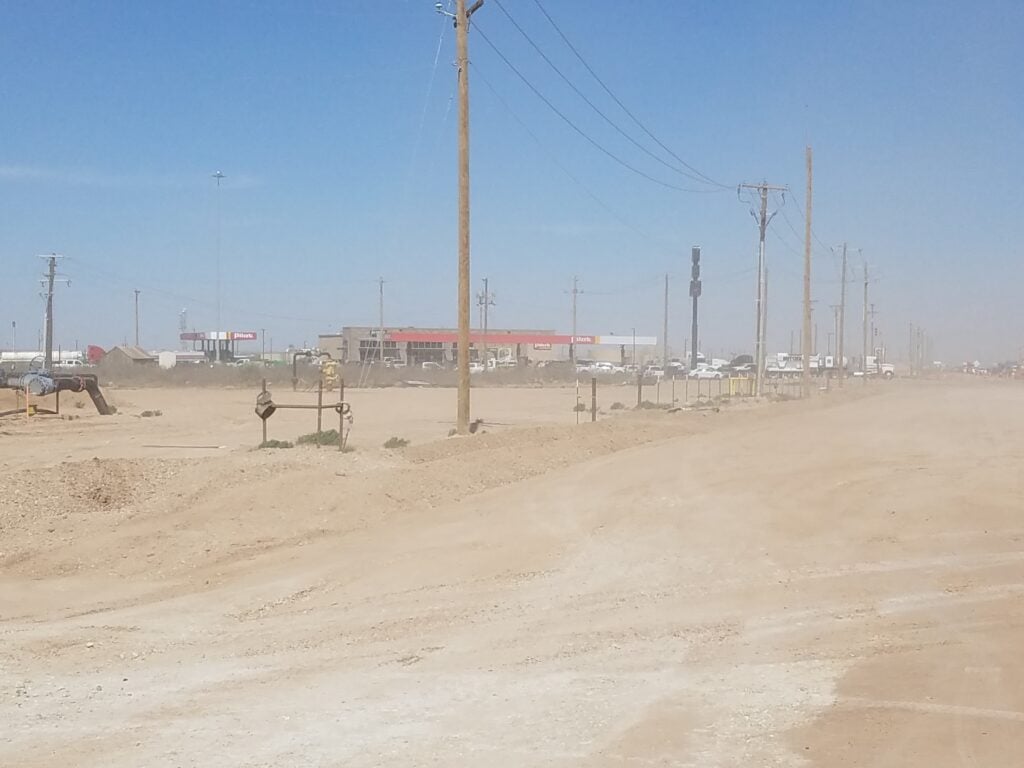
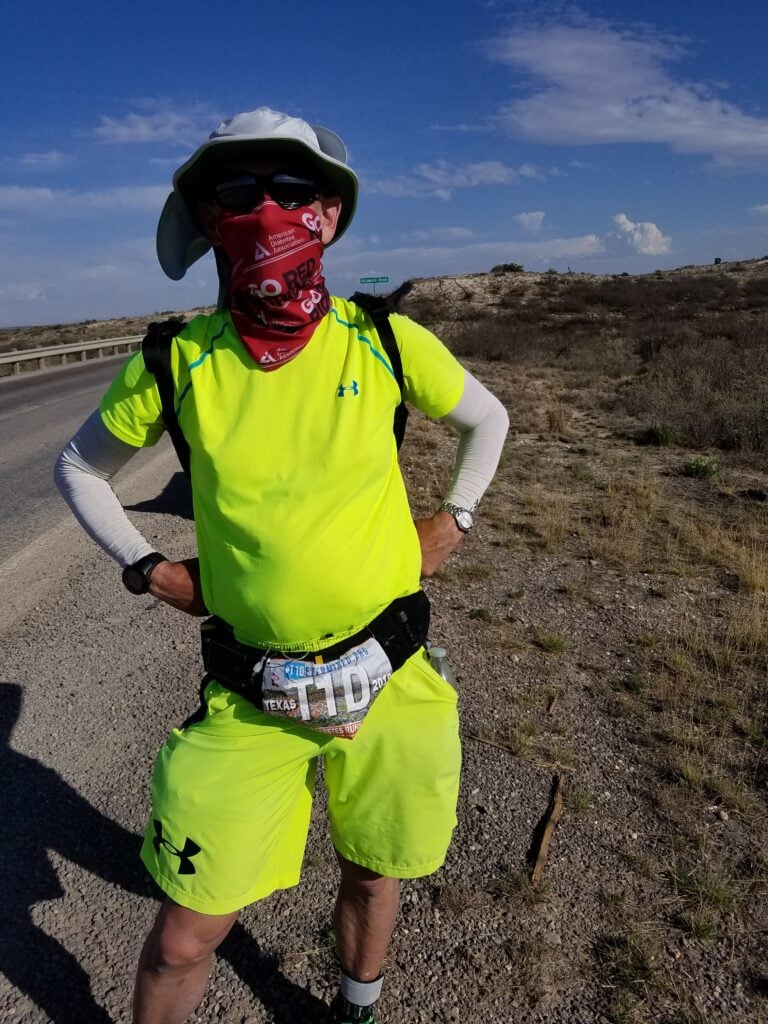
In practice, I found the Shelta, plus a super thin neck buff, worked well in hot, dry, sandy places like Orla and Dell City, TX. That was as close as I ever got to Death Valley or the Sahara.
Gloves
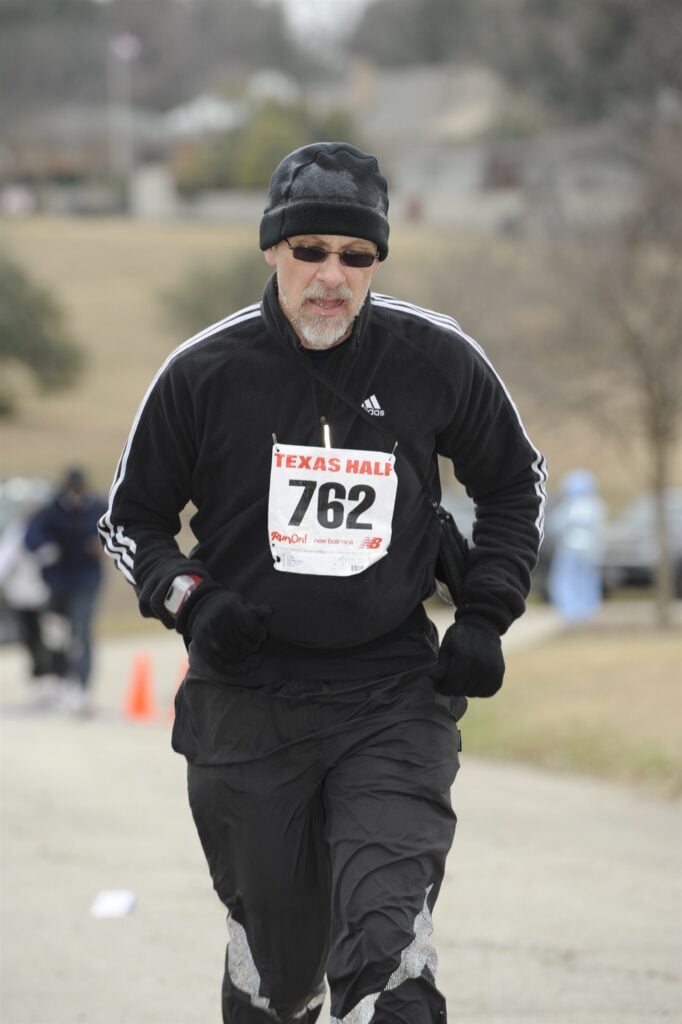
The North Face eTip running gloves used to be my go-to. I wore them for my first half marathon, the 2009 Texas Half, pictured above.
But the current model is too thick and lacks dexterity, defeating the “eTip” feature. Patagonia makes a similar glove, but lately they’ve been thicker as well. Which would be FINE if thick gloves actually worked.
The problem is that the thicker you make them, the more they warm up your hands, and eventually you face a choice: take the gloves off to keep from sweating, or keep wearing them until they’re soaked from sweat and actually make your hands COLDER when you take the gloves off.
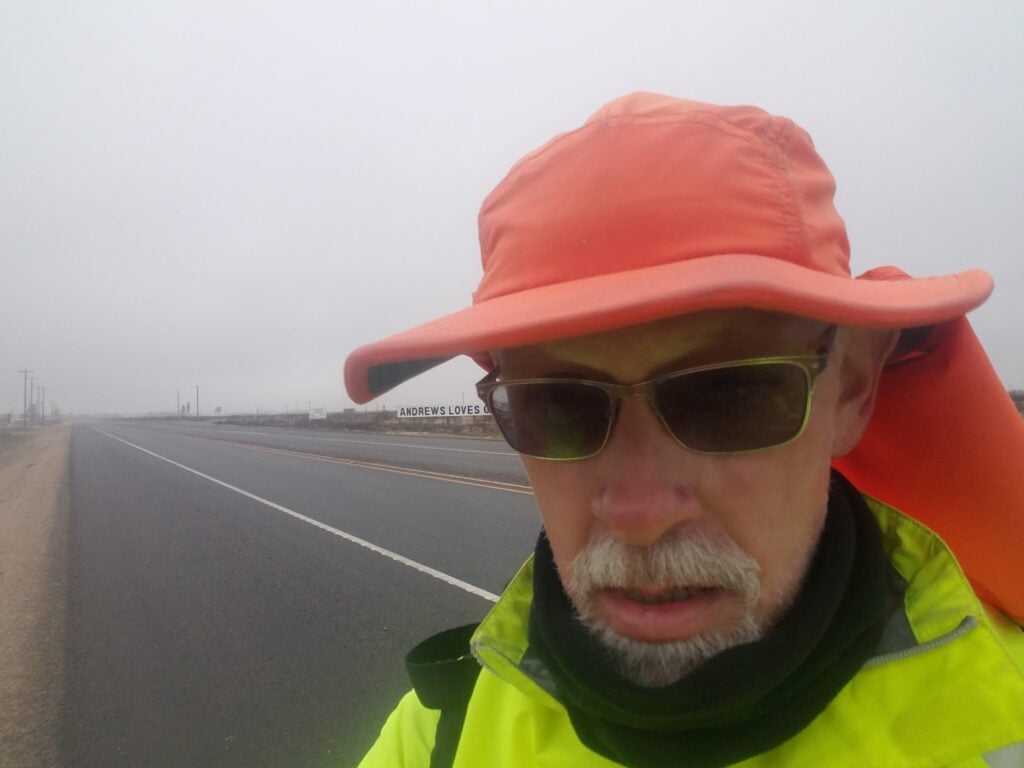
There was one day in particular that I remember gloves to have been a real challenge and it was in Andrews, TX in March 2020, just after I had left New Mexico, a few days before I was forced to put my Big Run on pause due to Covid lockdowns and empty grocery stores. It was miserably cold and wet, and it seemed like no matter what I wore, it wasn’t warm enough, and then minutes later, it was WAY too warm.
Much as with shirts, I learned to layer gloves and take the layers on and off to manage temperature and make sure I wasn’t sweating myself cold. Thinner gloves with a wind mitten allow not just more dexterity but the advantage of removing a layer as your hands warm up.
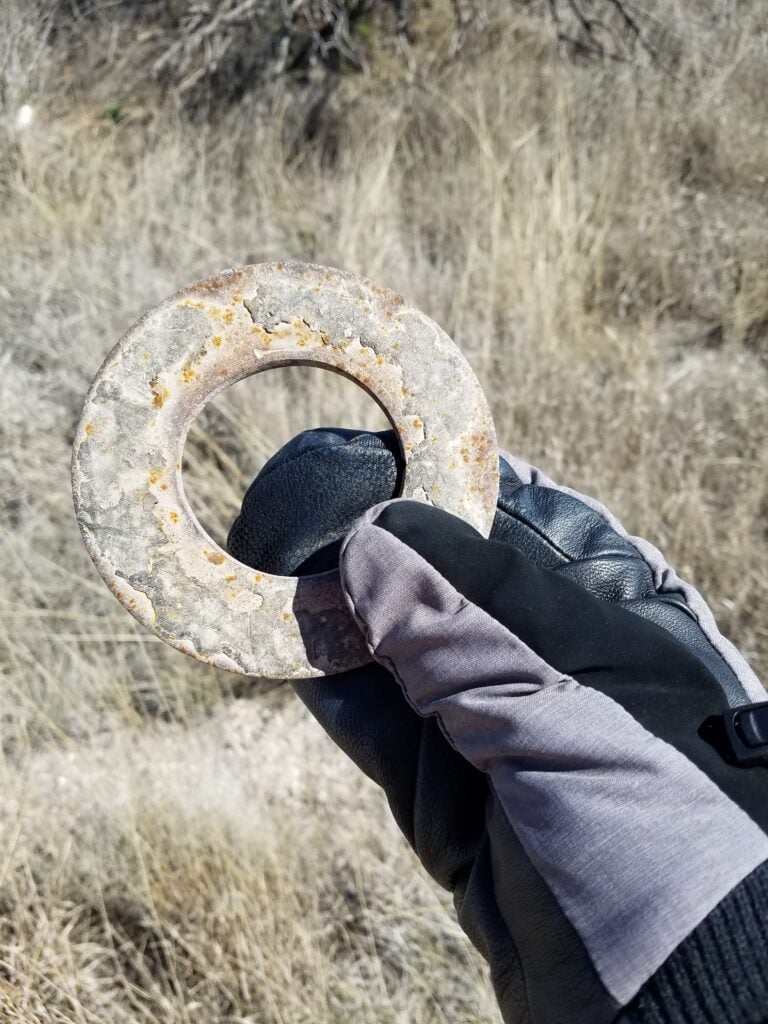
I also found that a combination of glove liners and wind mitts fit a very nice niche. SOME glove liners, such as the “sniper gloves” I got from an Army surplus store, allowed me to keep most of my fingers except the “trigger” finger together like they’d be in a mitt–yet still allowed enough dexterity for me to use my index finger.
Over that, I used thin wind mittens to keep out the first “layer” of weather. I used to wear InSport wind mittens, but sadly, those have been discontinued. Sugoi used to make the Versa Wind Mitt, but they appear to have been discontinued as well. Eventually, I gravitated to Outdoor Research Revel wind shells / mitts. Hopefully they’ll keep making these.
Neckwear
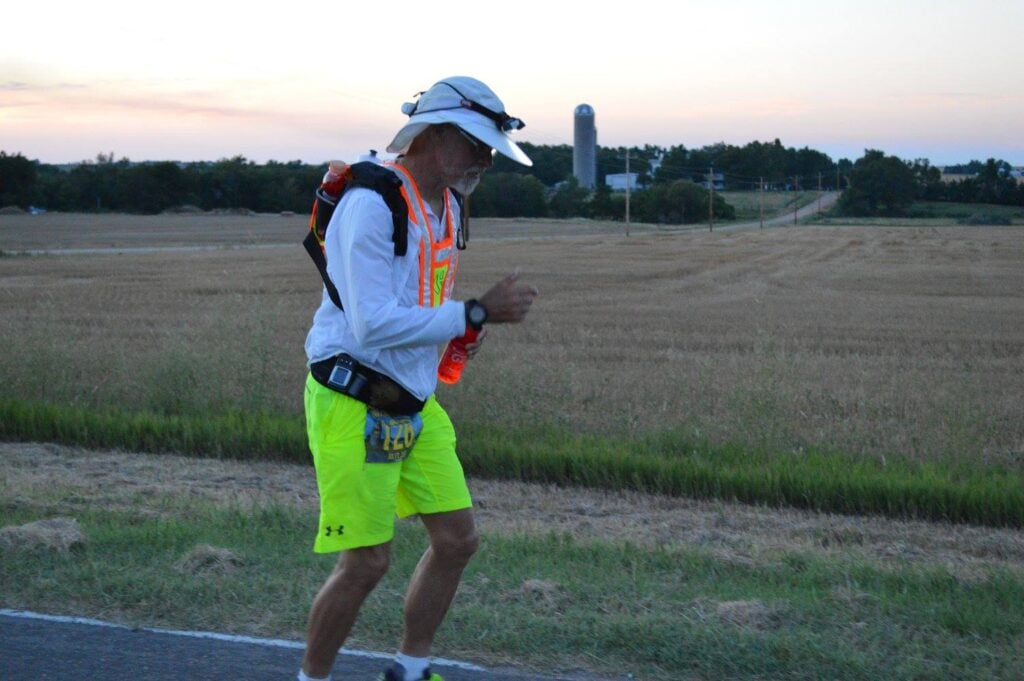
I never really thought about cooling neckerchiefs until I practically cooked myself at the Honey Badger 100, a 100-mile road race that’s held in July in Wichita, Kansas. It was nothing but hot roads going in a straight line through farmland. I had the sun hat. I had the desert shirt. I even survived full-foot blisters at mile 50 and being run off the road by an angry farmer at midnight, but what nearly did me in was the heat the next morning, and by mile 95 I was severely dehydrated, overheated, and just wanted my 34-hour sleep-deprived ordeal to be over.
My thinking quickly adjusted to accommodate the idea of neckerchiefs once I signed up for my first 200-mile run, a solo version of the now-defunct Capital to Coast 223-mile relay, which used to always start the third week of October in Austin, TX, where early morning temps were in the 40s (F) and mid-afternoon temps on the Texas Gulf Coast ran close to 100 F.
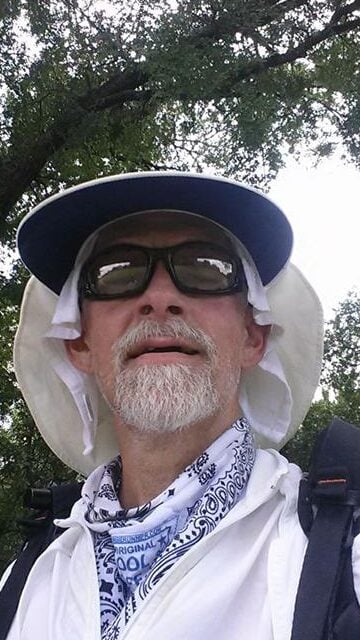
The idea behind cooling neckerchiefs is that you fill small Ziploc baggies with ice and drop them through the side-holes into a pocket that rests on your chest, under your shirt, so it won’t bounce. They’re incredibly effective, but as the ice melts, even though it’s in a ziploc, it seems to get everywhere, and I often found my shirts drenched, not knowing whether it was sweat or water, but certain that it was causing my insulin pump’s infusion site to sweat off.
But it doesn’t matter. It seems ZombieRunner doesn’t make them any more. There’s a company called The Feed that makes them now, but I haven’t tried them out.
Arm and Leg Coolers…and Warmers
Sun and Heat
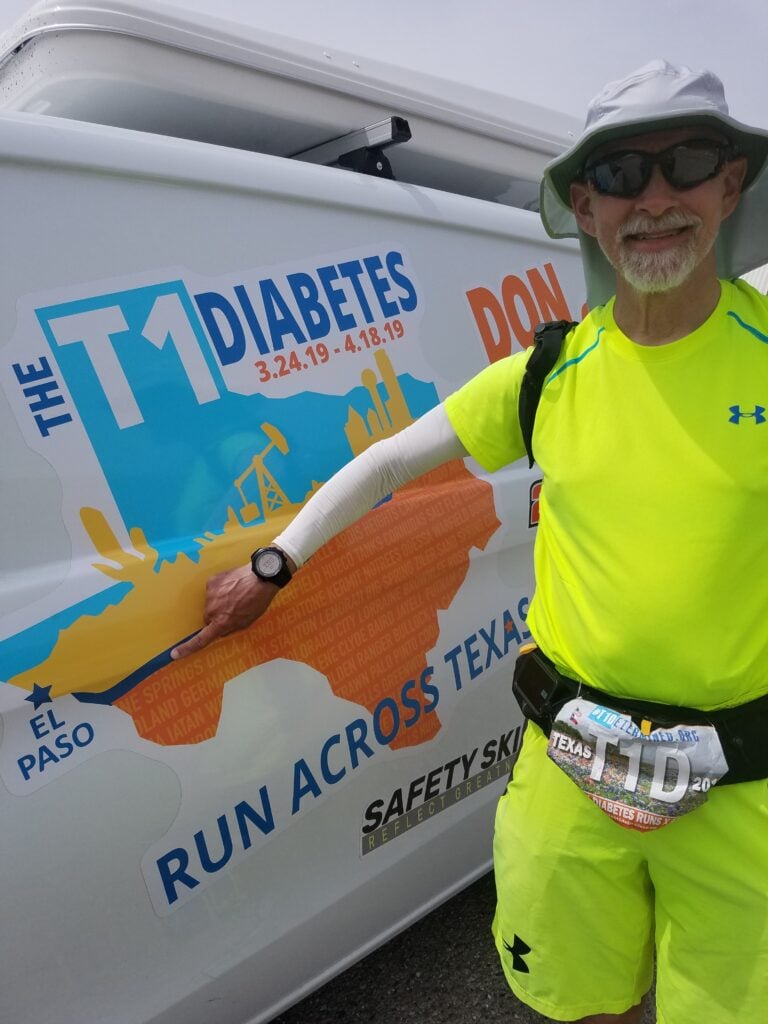
Approximately 70% of solar radiation makes it earth, and about a third of it is absorbed into the atmosphere. The remaining 2/3 makes it to the surface, where it interacts with the land–some of which gets absorbed and re-radiated as ambient heat. The rest YOU absorb directly, and even on a windy, sunny day, you can feel your skin cooking, and you know sunburn is on the way.
The trick, therefore, is to stop the sun from getting to your skin. A simple white long-sleeve shirt will do wonders, especially if it’s made of a thin, breathable fabric.
I didn’t really learn to accept this thinking until I did my first Run Across Texas in 2019. Even though I started in early Spring and ambient temps weren’t bad, the sun in the afternoon was unrelenting. It was bad enough in the west Texas desert that I found myself covering the sides of my face with a neck buff just to get the sun off.
De Soto Skin Cooler 90 arm coolers are the bomb when it comes to evaporating sweat. Once you start sweating, the cooling effect is quite pronounced. The only downside is that when ambient temps are ABOVE body temp, you’re a heat sink, so evaporation isn’t going to help you.
If you’re going to be running in the hot sun, you need a desert shirt.
Cold, Wind, and Rain
I’m aware that on my Gear Page, I recommend Asics running tights, and if you’re OK with having a hard time getting them off, they’re great. For instance, if you’re running a marathon and you don’t plan to make any bathroom stops unless you REALLY HAVE TO, they’re probably a good answer. That’s what I thought at first. I wore them, in fact, at the Texas Half.
However, I found tights to be a nuisance on any run long enough to require a bathroom stop, especially out in the middle of nowhere, as was the case on my 2019 Run Across Texas. I actually found Sugoi Midzero leg warmers a better bet, at least when it was dry. You can zip them off when your legs finally get too hot (they will, even in freezing temps), but until then, they keep your legs warm AND don’t prevent you from jumping behind a cactus and doing the needful.
Warming VESTS are ALSO a great idea. Shopping at at the expo for a long-ago Dallas Marathon, I stumbled upon a Pearl Izumi neoprene running vest. Unfortunately, the model I like isn’t made any more. I have been giving some serious thought to the Proviz Reflect 360 cycling vest, partly because it’s bright yellow in the daytime and reflective at night. Back in 2019 I also got a souvenir cycling gilet from the American Diabetes Association’s Tour de Cure DFW fundraising bike ride. It’s not as nice as the Pearl Izumi, but it holds some heat on a cold day if worn under a jacket. And it was FREE.
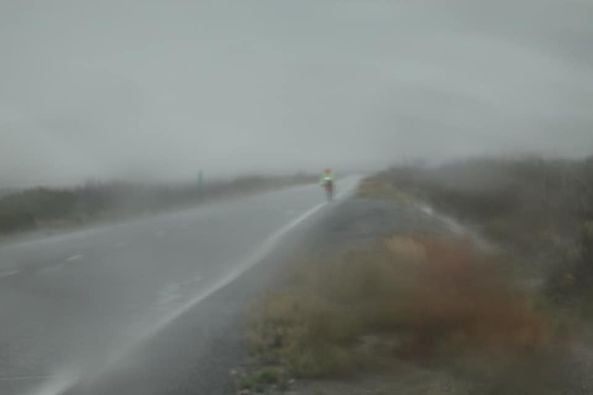
But best of all were the few pieces of RAIN gear I had–most notably, a pair of waterproof running pants that literally attached solely with Velcro, and a waterproof cycling and running jacket I had gotten opportunistically on closeout from a tri shop that was going out of business. I never thought I would use either of them, but I wore them BOTH at the beginning of March 2020, just outside of El Paso, when temps dropped suddenly, the wind kicked up, and the rains that had refused to come for many days decided to come all at once.
Visibility Gear
Visibility wasn’t a big deal when I was running regular events with fixed courses, street closures, aid stations, and medical staff. Once I started doing century bike rides and all-night runs, though, I found myself alone on country roads and at risk of being hit by motorists.
As a result, I’ve gotten more and more obsessed with hi-vis gear.
Good high-vis clothing is high-contrast enough to be visible on cloudy days, reflective or illuminated for dawn, dusk, and night, and UV-reflective on brutally sunny days. Here’s what I wear these days.
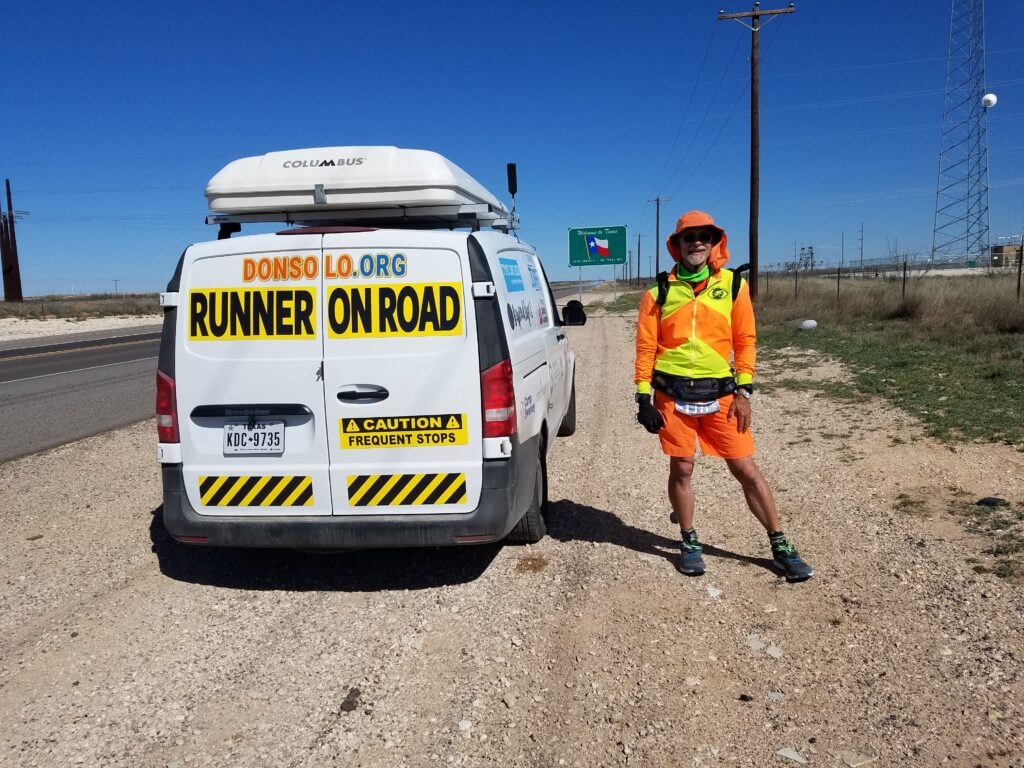
SeeMeWear: All their products feature an alternating hi-vis yellow and blaze orange chevron pattern that is visible from at least half a mile in daylight. It’s come to be my signature look, and that’s for a reason.
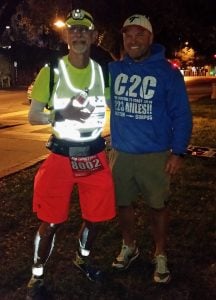
LED Light Vest. For a while, I wore the NoxGear Tracer 360, which is basically a plastic tube lit by tiny LEDs at the ends, which cause the tubes to light up in alternating patterns of color. However, the 3 AAA batteries wear out fast, and the only thing bright on the vest is the tubing. The GOOD thing about it is the weight: just ounces.
LED Light Vest is made to OSHA standards, designed for highway crews and first responders. It’s super-bright, around 700 lumens, and the rechargeable batteries last about ten hours. The vest is reflective as well, has a pocket for spare batteries, and the lights are hooded to prevent glare. With batteries, it weighs about half a pound.
Even without a headlamp, the LED Light Vest is so bright that you can run by its light, which I’ve done. It has blinking and solid light modes for both the front (bright blue) and rear (red) lights, and a small and breathable footprint, so it doesn’t feel like a rubber shirt.
Safety Skin reflective body marker. This has to be the coolest thing I’ve ever seen. It’s basically very similar to Body Glide but it’s impregnated with zinc, so it’s reflective. You draw on your exposed skin with a small stick of Safety Skin and you can’t actually see that you put anything on. Then turn the lights off and shine a flashlight at it, and you look like a glowing stick figure. It really works! Check the picture above — the one with the LED Light Vest. That’s Safety Skin on my legs.
Sadly, this product isn’t made any more. But I’ve been thinking for a long time about seeing if diaper paste–which is HIGH IN ZINC OXIDE–might do the job. I’ll let you know.
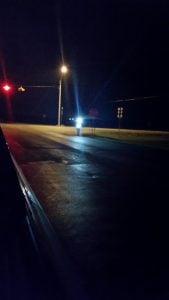
Petzl NAO+ headlamp. I started using this USB-rechargeable super-bright headlamp (750 lumens, half the brightness of car headlights) during the Capital to Coast Relay Solo Run. It was originally designed for spelunking, but is used by runners and construction crews. It auto-dims to avoid blinding drivers of approaching cars. At the brightest setting, it lasts about 4 hours, and at the dimmest, 10. You can switch the rechargeable batteries out, and in an emergency you can use ordinary batteries. My only complaint is that the batteries charge very slowly, so it’s important to always have a spare battery pack on the charger in the van.
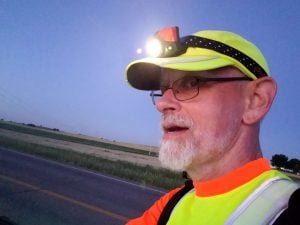
Coast FL85R headlamp. The Coast (formerly Coastal) headlamp has a high-intensity spread beam that seems to work better in fog than the Petzl; I’m not sure why. It uses ordinary AAA batteries, which it eats pretty voraciously at high intensity, and they can get VERY HOT if you wear the headlamp all night. I like the fact that you don’t have to charge it, and it’s more comfortable than the Petzl. It’s also VERY compact, so it’s easy to keep in a pocket or around your neck as a spare.
GPS Gear
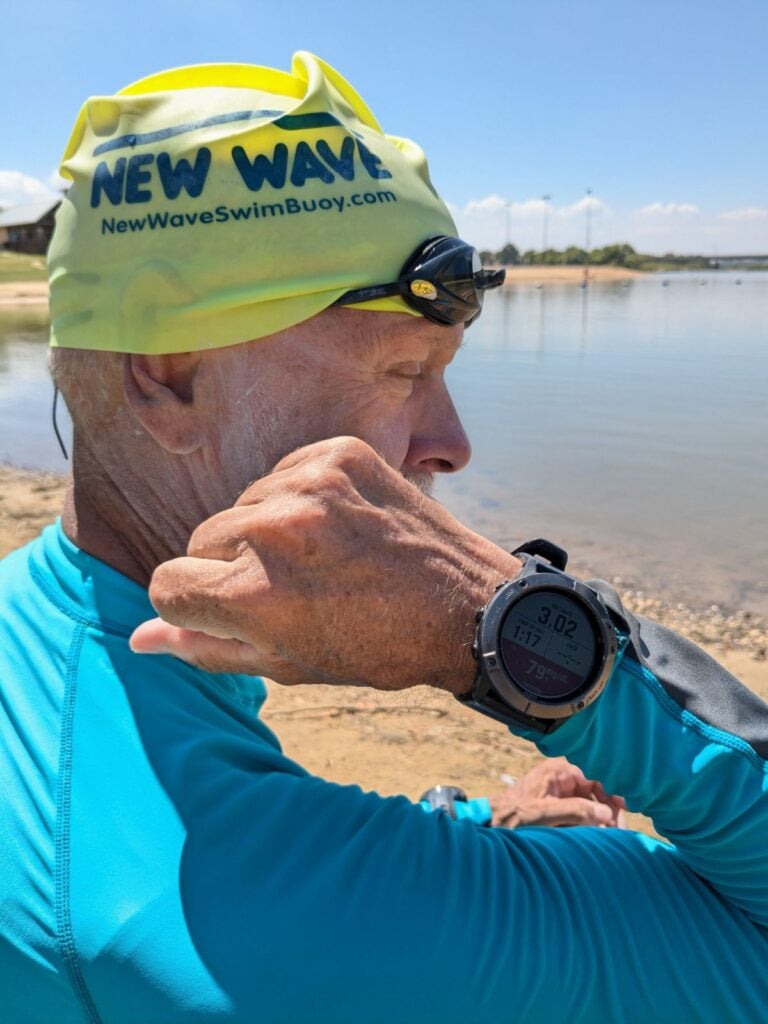
When I first started running, I wore a Garmin ForeRunner. A single charge was good for about 4 hours, enough to do a half marathon or fast marathon. But once I started running ultras, I needed something with a longer battery life. At the time, the Suunto Ambit 3 had the longest battery life.
But it also had an irritating problem: back when I did my first run across Texas, my Suunto Ambit 3 GPS watch suddenly stopped recording ANYTHING past 1000 kilometers. Apparently the engineers at Suunto didn’t believe anyone would run that far. The watch summarily stopped my workout at 625 miles, even with good storage space and battery. More recently, it spontaneously changed units of measure during a run. Not cool. I do own a Baro 9, but I haven’t been willing to gamble another 850-mile run on whether it has the same problem.
Instead, I switched to a Garmin Fenix 6 Pro Solar, because it allowed me to see my Dexcom blood glucose numbers while training for a 12.5-mile swim around Key West. It also has a 21-day battery life, extended by the fact that it does solar charging. That’s what I’m wearing now.
Shoes
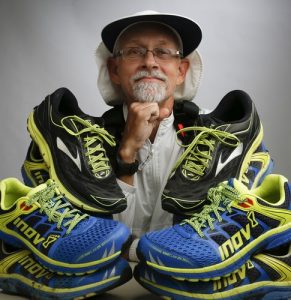
I don’t remember the first pair of running shoes I ever bought, but I know what they WEREN’T: comfortable.
I basically picked something off the “Top 10 Best Running Shoes” list from an article that had been written as clickbait for some running magazine. Best for WHOM? For WHAT distance? WHAT TERRAIN? What SEASON? I didn’t know.
I made every mistake in the book: I laced them too tight, wore the same size as my street shoes, and wore thin-soled flats good for setting a PR on a 5K but miserable running anything longer. They rubbed, chafed, blistered, and gave me plantar fasciitis.
The running I did on the Texas and U.S. runs was a bit unusual. It was about 95% asphalt and 5% gravel) for hundreds of miles. I needed a fairly lightweight, comfortable running shoe with breathable uppers, reasonable cushioning, and hard rubber lugs than can take a punch from a sharp piece of gravel on a back road. Ideally, that would come in a single shoe. During my initial research, I narrowed my choices down to the Topo Ultrafly and the Inov-8 Roadclaw, and near the end, considered the Brooks Transcend. After running in the Topos for forty or fifty miles, I decided they weren’t for me. They felt like beach sneakers in terms of support and sole thickness. That left me with two good options.
Inov-8 Roadclaw 275: The Roadclaw had a bigger toe box; interestingly, unlike Altras, the toe box room is vertical, not spread out like clown shoes. Also, the Roadclaws felt a bit more cushioned on the uppers, and since I was concerned about chafing, I went with the Roadclaws. I loved them so much that when I packed my 8 pairs of shoes for my run across Iowa, I ended up wearing the same pair of Roadclaws all 339 miles across the state. The manufacturing quality is fantastic. As you might expect, I value durability. And the nice thing about Roadclaws is that at least for now, they seem to be a bit of an undiscovered wonder, so they’re not overpriced. The only downside is that they don’t have much arch support.
Brooks Transcend. (See photo above; NOTE: These are now called Brooks Glycerin GTS.). I know that a lot of runners who want a comfortable shoe go for Hokas. I’ve tried them, but they’re so cushioned that my feet get hot and my ankles tend to roll on the super-thick soles. To me, the Brooks Transcend is the answer to what Hoka was trying to accomplish — a super-comfy shoe that you can still run in when your feet hurt like hell from running the last 40 miles. I bought three pairs, each a size larger than the last, and when I know I have only 50 miles to go in a multi-hundred mile road race and I feel like I am running on stumps, I switch to my Transcends. They’re also my go-to shoe for the long ride back from the finish line.
Foot Care
Lubes
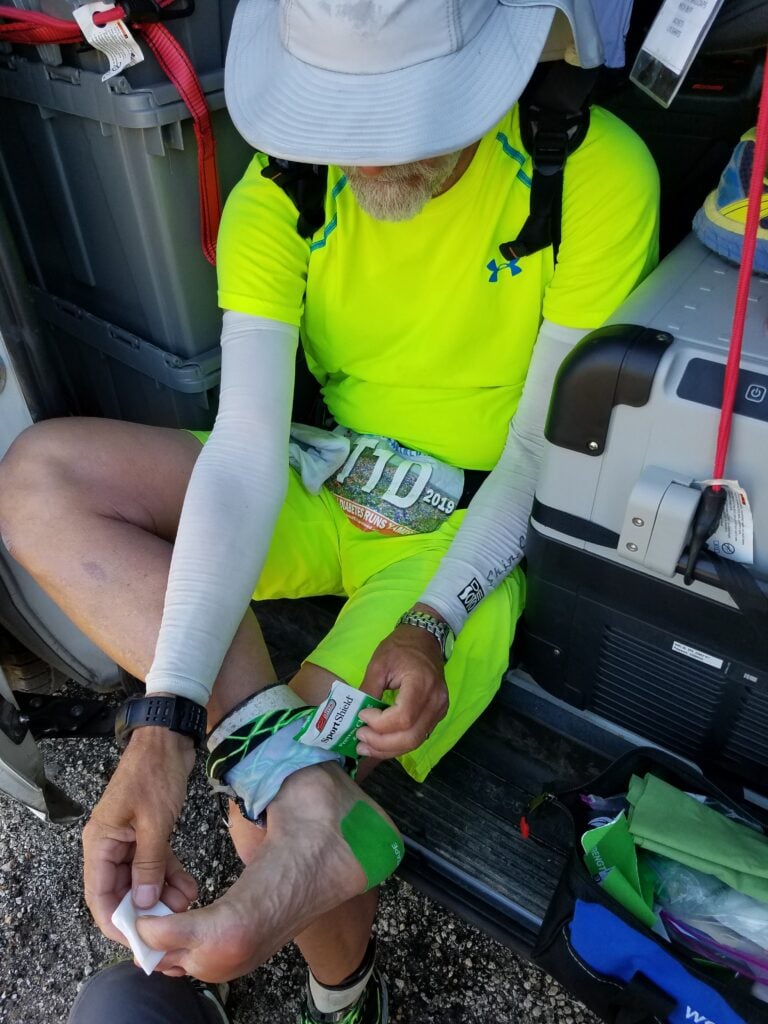
I didn’t care about lube until I suddenly did, when I encountered full-foot blisters at the halfway point of the Honey Badger 100-mile race.
2Toms Sport Shield foot lubricant is non-toxic, dimethicone-based foot lube that washes off with soap and water. It’s like WD-40 for your feet. It even feels like it. It does a fantastic job of preventing friction inside your socks, which his usually what leads to blisters.
There are two times to use Sport Shield. First, on your feet before you need to put on any tape, and AFTER you’ve realized you need to treat a hot spot that DIDN’T get lubed. In that case, put the tape on your foot, and the lube on the tape so it doesn’t rub your shoes.
Tape
Strength tape, kinesiotape, or moleskin–everyone has a preference, but the main thing is to have something rip off your feet that isn’t skin. Put it on after you lube your feet, then lube the tape. THEN put on your socks…and be PICKY about the socks.
Socks
I believe I discovered Wrightsock anti-blister socks AFTER the Foot Fiasco at Honey Badger. At that point, I wanted ANYTHING that helped prevent blisters.
After Sport Shield, the next best thing is to wear socks that are made up of two very thin layers rather than a single thick layer of fabric. Wrightsocks are breathable wicking fabric socks that are designed to allow the inner and outer layers of your sock to slip past each other when your feet strike the ground, rather than transferring the force of friction to the soles of your feet. A word, though: if you use foot lubricant and anti-blister socks, your feet will slide more in your shoes. You will almost certainly need to master the lace lock technique for tying your shoes. Here’s a video.
The key here is the TWO LAYERS. Wrightsock makes a lot of different kinds of socks, and most of them are available at The Running Room. I used WrightSock Endurance and Coolmesh. The Endurance hold up a little better and the Coolmesh are more comfortable to wear.
Gaiters
Finally, gaiters protect your shoes from accumulating bits of dirt, seeds, grass, etc., through the uppers and ankle collars. After repeatedly encountering cockleburs during my solo run of the 223-mile C2C Relay, I was determined to avoid the problem if at all possible. By the time I did Relay Iowa’s first solo 339-mile run, my bright yellow Outdoor Research Sparkplug Ankle Gaiters were a standard part of my repertoire.
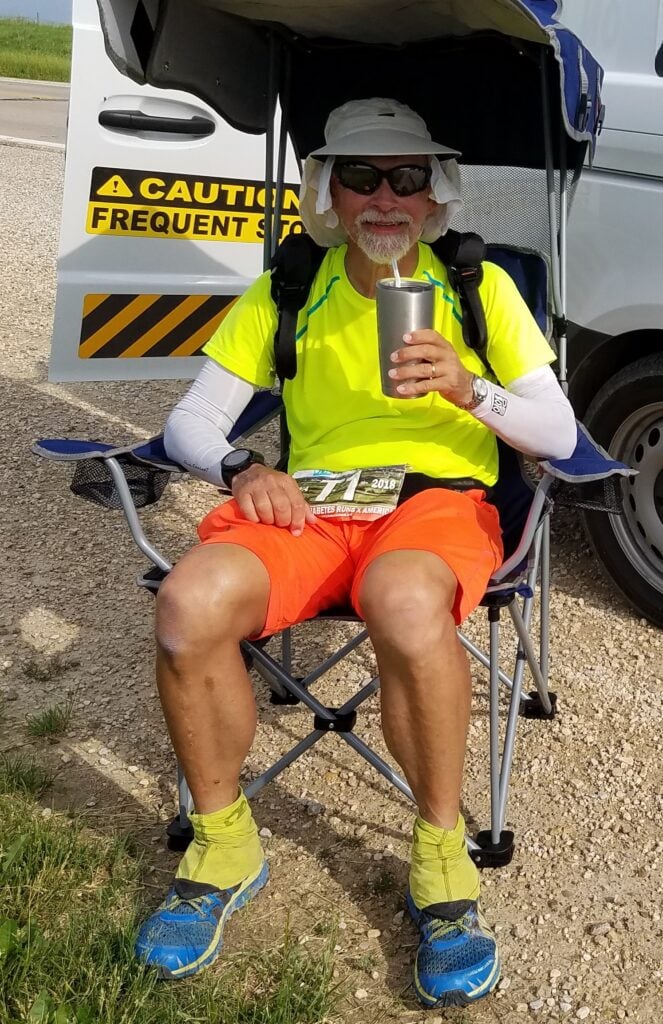
I especially liked these gaiters because they used Velcro to fasten at the heel and there’s a hook that fits over your most distant shoelace loop, near your toe. Most other gaiters were either custom-fit to a particular brand of shoe or they rely on an under-heel strap, which I typically wear out quickly on long runs.
Unfortunately OR has discontinued the Sparkplug, but a very close clone is Dirty Girl gaiters. I wore those on the USA run, along with some rain gaiters I found at REI and some desert gaiters that I used for the beach portion of my USA run at the start in Newport Beach and the finish in Indialantic.
Hydration

I used to just carry a water bottle in my hand, but I soon discovered that holding it even SLIGHTLY in front of myself on long runs caused me to adjust my posture by leaning forward, ultimately giving me creeping back pain that I didn’t notice until it was a problem.
That wasn’t a problem on marathons, which had aid stations. It wasn’t even a problem at Ironman Texas.
But once I graduated to ultras, finding a way to carry water that wouldn’t weigh me down, make me sweat more, or give me back pain got to be a significant issue.
The first thing I tried along these lines was an Osprey hydration pack with a plastic bladder you could refill by unscrewing the lid that rested near the top.
As long as the pack was full of ice, it wasn’t a problem. But as the ice melted, the smothering layer of warm water on my back just felt suffocating. So I looked elsewhere.
I discovered the Orange Mud single and double-barrel HydraQuiver. This is an awesome ultra hydration vest created by a guy who is actually a long distance runner and wears his own product. The double-barrel holds two filled 25-oz bottles. I’ve tried hydration bladders, and the water in them gets pretty skunky after it warms up. Bladders are hard to change out without a big ritual of emptying and refilling. The other factor with bladders is that they cling to your back and don’t allow you to bleed off heat. The HydraQuiver holds bottles, which are easy to change out or refill, and the vest makes an “X” pattern on your back, letting heat escape from around your shoulder blades. The load rests a bit high on your shoulders, where it balances perfectly and avoids the postural discomfort of carrying water on your middle back, lower back or chest. It has two elastic pockets for storing gels or a cell phone. I usually put a spare pair of glasses or gels in one and my InReach in the other. It also has a small zipper pocket where you can put ID, a pair of gloves, keys, or similar small items. The Orange Mud vests are super light (comparable to an Ultimate Direction SJ Ultra), store more than the SJ, and come in high-vis colors as well as black. My favorite for crewed runs is the orange single-barrel HydraQuiver.
Miscellaneous Gear
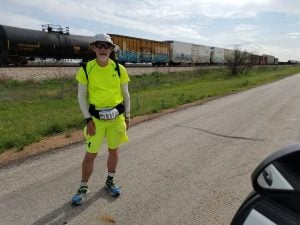
Ever since I started running, I’ve wanted a waist pack that would allow me easy access to my glucose meter and lancing device, test strips, ID, phone, and a place to put gloves, arm warmers and maybe a gel. I looked at the SPI Belt, which worked on the assumption that I wouldn’t overload it! WHEN I did, it simply rolled. Eventually, I found another pack, the Amphipod Enduro, which is flat and spread out, like a Manta Ray and almost impossible to roll. But storage is limited and they’re hard to find.
The Naked Running Band fits like a cummerbund, and is VERY roll-resistant. You can stuff it full of practically everything short of a giant cartoon hammer, and it will make room.
Final Thoughts
I realize that my preferences are evolving–in fact, that was the whole point of this post–and that different challenges require different solutions. For instance, I didn’t use ALL of my USA running gear on the Deca Iron challenge. That was in large part due to the fact that I was running a well-worn suburban route that wasn’t brutally hot, brutally sunny, or full of cockleburs. I had known hydration stops no further apart than every 12 miles, so Thermoses in my HydraQuiver were perfectly adequate to the task.
And still, challenges arise. For instance, I learned both in the Mojave and at Key West that between Bluetooth and cellular, it’s not always possible to get a signal out about your location without using a satellite locator beacon. As a result, the Garmin watch and InReach are still in my gear list, but locator apps, which I tried for a while on my cellphone only to discover they were battery-drainers, are not.
As I learn new things, including what works for me NOW, for the things I’m DOING now, I’ll update this page.